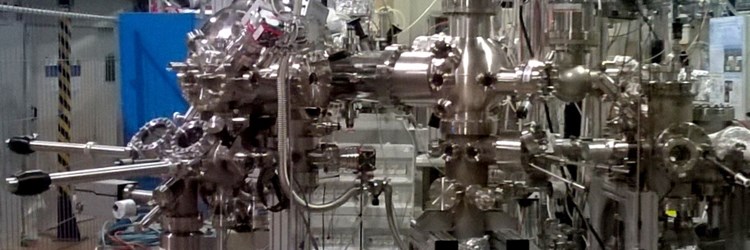

APE-LE is a beamline within Elettra dedicated to high resolution angle-resolved photoemission spectroscopy (ARPES) with Spin-resolution (Spin-ARPES), and thus employed in the investigation of electronic and spin properties of highly correlated electronic systems.
APE-LE is part of the APE-NFFA complex that is based on a state-of-the-art surface science laboratory as a support facility for advanced spectroscopies at two distinct beamline end-stations (APE-LE and APE-HE) using polarized synchrotron radiation in the ultraviolet and soft X-ray range from the Elettra storage ring.
APE-LE is part of the APE-NFFA complex (http://trieste.nffa.eu/) that is based on a state-of-the-art surface science laboratory as a support facility for advanced spectroscopies at two distinct beamlines (APE-LE and APE-HE) using polarized synchrotron radiation in the ultraviolet and soft X-ray range from the Elettra storage ring. The sample preparation and survey represent crucial and integral part of our experiments. For this reason the interconnected set of UHV chambers within the APE-NFFA complex allows for state-of-the-art sample growth by in situ pulsed laser deposition (PLD), advanced surface preparation (Ar ion sputtering, annealing, controlled evaporation, LEED/Auger characterization, Kerr magnetometry) and characterization by atomic resolution scanning tunneling microscope (STM) and also by XPS/XAS (at APE-HE), prior to spectroscopic studies of the electronic band structures and related spin textures (ARPES and Spin-ARPES).
Detailed technical description of all apparatuses operating within APE-LE (ARPES / Spin ARPES, PLD, Surface and Nano Science Lab and STM/S facilities) are available at:
http://trieste.nffa.eu/areas/spectroscopy/arpes-and-spin-arpes/; http://trieste.nffa.eu/areas/growth/pld/;
http://trieste.nffa.eu/areas/characterization/surface-and-nano-science-lab/;
APE-LE hosts VESPA, a unique facility for Spin-ARPES at Elettra, fully developed, built and commissioned within NFFA. Its operation is based on the exchange coupling between the photoelectron spin and a ferromagnetic target in a reflectometry setup (VLEED concept). VESPA is integrated with a dedicated Scienta-Omicron DA30 ARPES analyzer allowing for distinct measurements over the selected Brillouin zone areas that, after magnetization switching of the two targets, allow the three-dimensional vectorial reconstruction of the corresponding spin texture. The discovery of new topological phases characterized by peculiar spin textures contributed to the extremely high request for Spin-ARPES (APE-LE oversubscription ratio ~4).
A second PLD chamber is currently being developed at APE-LE. It will be optimized for deposition of metallic layers (Nd:YAG as opposed to present KrF excimer, currently adapted to oxides and semimetallic (topological) materials). The second PLD will be UHV connected to the rest of the APE complex through also in-house developed and built UHV transfer system.
The research at the APE-LE beamline exploits angle resolved photoemission (ARPES) and ARPES with spin resolution (Spin-ARPES) in the investigation of electronic properties of materials, in particular the electronic band structures, related spin textures, Fermi surfaces and Fermi surface instabilities. APE-LE is dedicated to the investigation of highly correlated electronic systems, spintronic materials: topological insulators and systems with strong spin-orbit interaction in general, transition metal oxides, low-dimensional electronic systems, superconducting materials, surfaces, molecular films on solid surfaces and magnetic materials. Recently developed in-situ PLD facility (and also UHV transfer through a vacuum suitcase from oxide MBE) allows us to investigate the materials where the electronic properties are finely tuned through material nano-engineering. The research at APE-LE is further substantiated by the complementary in-situ STM characterization of the surface structural and electronic properties.
All APE-LE facilities have been implemented with the support of the NFFA research infrastructure projects that aim at continuously developing and operating an integrated users access infrastructure along with APE-HE, NFFA-SPRINT and with partial involvement of other IOM (S/TEM, MBE-nanowires) and SPIN (PLD, Theory) activities, using dedicated resources from national and EU grants under the responsibility and coordination of Giorgio Rossi (Università di Milano and IOM-CNR).
MIUR-FOE, NFFA , 2013-present
MIUR, Eurofel-APE (former Ab Nanotech), 2014-present
ICTP TRIL PROGRAM, ICTP, 2016-present